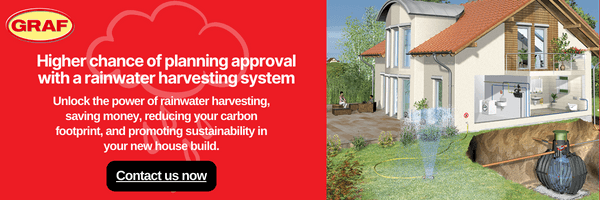We don’t need to remind you that the weather in the UK is often rainy. In fact, our average rainfall is between 800mm and 1,400mm a year. The wettest city in the UK is Cardiff.
The average 4-person household in the UK uses around 500 litres of water a day. Household use means using water for the garden, cleaning the house, washing the car, flushing toilets washing clothes in the washing machine and using a dishwasher.
The average monthly water bill for a 4-person household is around £588 a year or £49.00 a month.
So, considering we have so much rain doesn’t it make sense to collect (or harvest) some of the rainwater to use in the garden, for washing the car, flushing toilets, and washing clothes?
Harvesting rainwater will mean you’re using less water from the mains and therefore you can reduce your water bill.
Is Rainwater Harvesting Illegal?
No. In the UK it is not illegal to harvest rainwater to use in domestic or commercial properties. Some builders of new houses who install some kind of rainwater collection facility could be more likely to get planning permission than those who don’t.
Do you need planning permission to install a rainwater tank?
No, it is unlikely you will need planning permission to install a tank unless you live in a listed building or a conservation area. Saying that it is still always best to check with your local planning department before you get any work done.
Are there any regulations for installing a water harvesting system?
Yes, there are regulations about the installation of a rainwater harvesting system. These are part of building regulations and water supply (water fittings) regulations 1999. They state that all non-potable (water you can’t drink) must be in separate pipework and labelled clearly. This is to stop any non-potable water causing contamination of drinking water which might cause E-Coli.
Pipes must be separated by means of an air gap which means there must be an unobstructed and visible break between the lowest level of water discharge and the level of rainwater between a cistern or appliance.
How much can I save if I collect water?
If you use your water for flushing the toilet and in your washing machine inside your home and gardening and washing the car outside, you could save up to 50% on your water bill. This could mean a reduction of around £24.50 a month for an average four-person household.
Are there any other benefits to having a rainwater harvesting system?
Yes. As well as saving money you are also reducing your carbon footprint. By using rainwater, you are taking less water from rivers and reservoirs. Collecting water also reduces the risk of run-off water causing floods in heavy rain.
How do I know what size tank to buy?
If you have a look at our website, you’ll see a questionnaire. The questions ask you about the size of your roof (we show you how to get the measurement). We also need to know your postcode so that we can have a look at the average rainfall in your area.
After that, we need to know how you want to use your rainwater, for gardening use only or for your household as well. Once you’ve answered the questions, we’ll let you know what type of tank will suit your needs.
Is the installation complicated?
Not at all. It will take a professional installation team about a day to complete the work.
Where can I have a tank installed?
If you have room in your garden, then an underground tank will save you space. You can also have a tank installed in your loft or above ground outside. An underground tank will use a pump system powered by electricity. A tank on your roof can have a gravity feed system.
What are the advantages and disadvantages of underground and above-ground systems?
As we have said, the one big advantage of an underground tank is that you save space in your garden. There’s less risk of algae in the water too because underground there’s no light. The disadvantages to an underground system are that it isn’t as easy as an above-ground tank to access for maintenance or repair and the installation will cost more because you have the extra cost of excavating the land to fit the tank and removing spoil from the site.
On the other hand, an above-tank has the advantages of easier access and it’s less expensive to install. But more light will get to the water which may cause algae growth and exposed pipes are at risk of frost damage in the winter.


